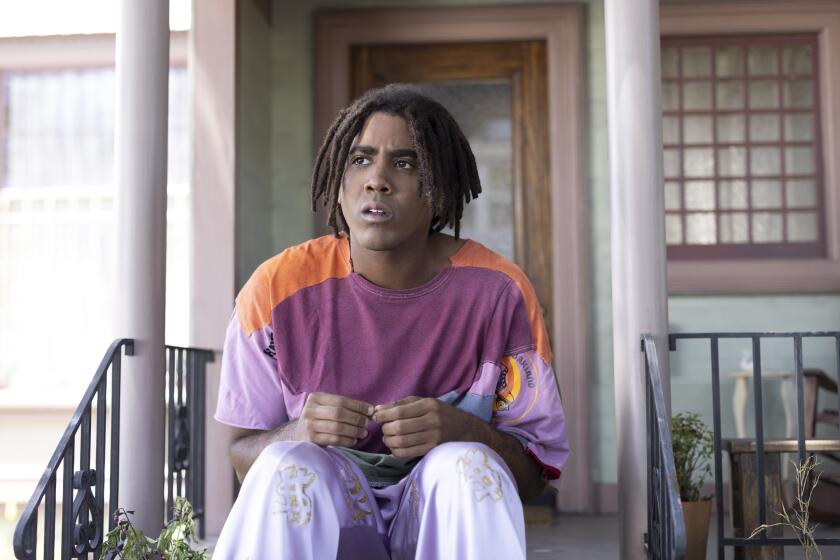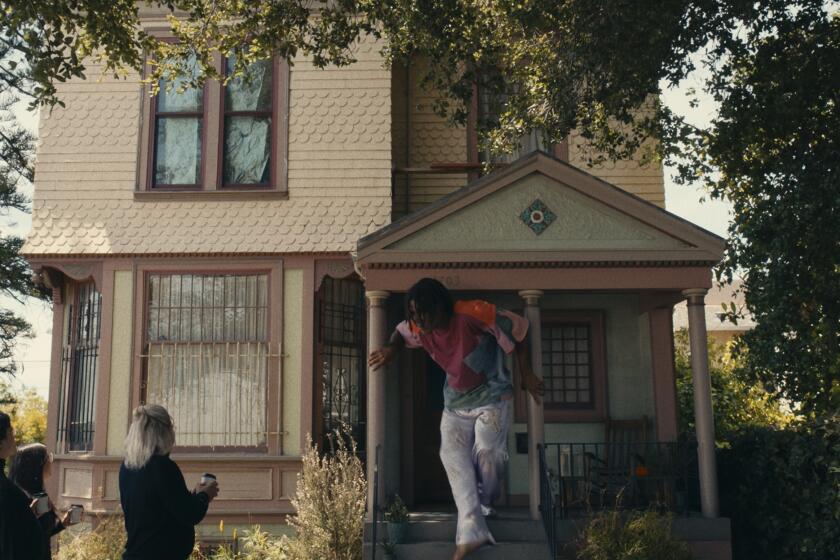
- Share via
To say that Boots Riley is an unlikely showrunner is an understatement. The Oakland-based filmmaker, hip-hop MC and political activist is probably the only self-identified communist in the entertainment industry.
With his latest comic provocation, the absurdist seven-episode miniseries “I’m a Virgo,” Riley brought his brand of anticapitalist urban surrealism to Prime Video, garnering widespread acclaim during a summer of labor unrest. “Virgo” follows the adventures of Cootie (Jharrel Jerome), a 13-foot-tall Black teenager who was raised in seclusion, as he emerges into a surreal, dystopian present-day Oakland.
Speaking from his Oakland home, Riley explained why he’s not planning to compromise, no matter which megacorporation is bankrolling his project.
The Prime Video series about a 13-foot-tall teenager living in Oakland was created and directed by Boots Riley.
You haven’t left Oakland, and both “Virgo” and your previous “Sorry to Bother You” are set there. What makes this city so important to your artistic process?
I’m a better artist when I’m here. I grew up here. I know what each building means, and I have a reason for choosing locations other than just what the lines and colors look like. The general way that film and television is made is about making every place into no place. And that way it can easily be molded and sold to be anything. But I believe that the more specific you get, the more you make someone feel attached. Think about the greatest lyrics by songwriters who get very specific. You don’t know who they’re talking about or know that situation, but you feel their passion because of the detail that they put in there.
Tell me about working in TV for the first time — did you feel a new sense of freedom or new constraints?
There’s always a new set of constraints. And with TV, there is a specific way you’re supposed to do things. And my art is very specific, very weird, very strange. There were a bunch of experts that weren’t involved with the show that could chime in and say, “That’s not the way you do it.” From the practical effects and the way we shot it, to the way we had to schedule it around those things, to the story structure itself. Like, everything about this show was done wrong. And that’s part of what tickled me about being able to do it.
The show has a distinctive look, with a tactile, handmade feel. What can you tell me about the production design?
I’m inspired by folks like [painter] Jacob Lawrence and Parliament-Funkadelic, who take different textures and slap them on top of each other. And you feel that in the editing style, the production design, because that’s what Oakland is. There’s a cultural and political hodgepodge that comes out in the beautiful clutter of the production and costume design.

It goes with the whole theme of everything I do — many people say about my art that I’m “doing a lot.” It’s like a good plaid or a paisley. There’s a way to do it where it starts dissonant and then moves into harmony.
Your protagonist, Cootie, is 13 feet tall. What can you tell me about the challenges of fitting this character into the frame?
First of all, I just really like wide, anamorphic frames. Since Cootie is so tall, everybody was like, “We should not do that wide aspect ratio.” But I wanted to start with the thing I like and then we can squeeze everything in. As a result, you see him bending over a lot, and there are many scenes where we’re just showing parts of him, and we feel his size through that.
But yeah, we probably employed more puppeteers than any show outside of “Sesame Street.” We had a 13-foot puppet that required at least four puppeteers, plus a separate costume person to make it happen each time. Then we had half-scale puppets for the rest of the cast. This way, we could move more quickly without forced perspective. You could do it with CGI, sure, but your eye could really tell the difference.

You are the only communist in showbiz. Do you feel more political camaraderie since the WGA and SAG-AFTRA strikes?
Well, if there were more [communists] already, I wouldn’t have gotten into filmmaking. So I’m here for a reason. I believe that so much of what I say, a lot of people agree with. You know, I’m a product. I’m not special. I didn’t just decide to be virtuous. When I joined radical organizations in the ’80s, there were people in those organizations in their 50s, 60s, 70s and 80s. As a teenager, I got connected to this vast history of people that had a lot of experience. A lot of those folks were very humorous people that helped create my sense of humor.
I think there was a lot of unity [in Hollywood] around the strikes, and then, unfortunately, divisions happened … everything going on in Gaza.
‘I’m a Virgo’s’ production designer breaks down the show’s use of architecture. Plus, a dance residency born of the pandemic, in our arts newsletter.
A couple weeks before Oct. 7, I was on text with Amy Schumer all the time. I had a call with Michael Rapaport about the SAG strike. So there was unity, disunity, people scared, all of those things. We’re taught to be scared, politically and creatively. A lot of people are scared to tell the studio that they want something specific. They’re scared of seeming unreasonable or difficult on an artistic level.
But nobody can scare me with that. I never did what I’m doing because I thought it was a good way to make a living. In 2015, I was squatting in a house. Before that, I was somewhere else, 10 months behind on the rent. I was on food stamps while we were making “Sorry to Bother You.”
But because I have a larger goal, I’ve been fine with being broke.
More to Read
From the Oscars to the Emmys.
Get the Envelope newsletter for exclusive awards season coverage, behind-the-scenes stories from the Envelope podcast and columnist Glenn Whipp’s must-read analysis.
You may occasionally receive promotional content from the Los Angeles Times.









